[dropcap]R[/dropcap]ussia and China are both under attack by a multi-pronged U.S.-led ‘proto-war’ which could erupt into ‘hot war’ or even nuclear war. ‘Protowar’ or ‘proto-warfare’ is the term I have coined to describe the use of multiple methods intended to weaken, destabilize, and in the limit-case destroy a targeted government without the need to engage in direct military warfare.
Protowar methods include threats against the targeted country; economic sanctions; military encirclement around its borders. cyber-warfare, drone warfare, and use of proxy forces from within or from outside the country for political and/or military action against the local government.
U.S.-led protowars also invariably include propaganda campaigns against the targeted governments. The media campaigns are waged by the five giant media conglomerates which now control 90% of the U.S. media and which are directly linked to the U.S. foreign-policy establishment through various means including corporate memberships in the Committee for Foreign Relations.
You can recognize these media campaigns because they frequently employ the words ‘human rights’ or ‘democracy’ as the pretext for U.S. state protowars against other countries. Sometimes, of course, these words cannot possibly be applied at all, as in the massive support currently given to the murderous military dictatorship in Egypt or the midevilist kingdom of Saudi Arabia. In these cases the U.S. media and government substitute the words ‘U.S. National Interest’ for ‘human rights’ as the pretext for targeting another country.
Proto-warfare often precedes, or leads up to, hot wars, as when a decade of economic sanctions, media demonization, and media-supported lies about ‘weapons of mass destruction’ led up to the Iraq war. Thousands of young American men and women were sent over to kill and be killed, or to be injured or traumatized, to say nothing of the up to a million Iraqis who died as a result of the war. However, Iraq did not possess nuclear or other weapons of mass destruction, so there was no danger of a nuclear conflagration. Matters are much different with respect to Russia and China, both nuclear powers.
The ProtoWar Against Russia and China
U.S.-led proto-warfare against Russia and China has a number of elements. To begin with, it conforms to two popular doctrines in U.S. foreign policy circles. The first doctrine states that the U.S. must never allow another super-power to emerge, and must remain the unchallenged dominant force on Earth. This doctrine is clearly set-out in the original version of the U.S. Defence Department policy document known as ‘the Wolfowitz doctrine:
“Our first objective is to prevent the re-emergence of a new rival, either on the territory of the former Soviet Union or elsewhere, that poses a threat on the order of that posed formerly by the Soviet Union. This is a dominant consideration underlying the new regional defense strategy and requires that we endeavor to prevent any hostile power from dominating a region whose resources would, under consolidated control, be sufficient to generate global power.”
The document containing this statement and similar notions was changed for public consumption after the original provoked an outcry when it was leaked to the press.
The second doctrine underpinning proto-warfare against Russia and China is that U.S. dominance of the planet depends on control of the Eurasian land mass, on which Russia and China occupy key positions. This doctrine has been heavily promoted by former US National Security Advisor Zbigniew Brzezinski. “For America,” he has written, ” the chief geopolitical prize is Eurasia… Eurasia is the globes largest continent and is geopolitically axial. A power that dominates Eurasia would control two of the worlds’ three most advanced and economically productive regions… Eurasia is thus the chessboard on which the struggle for global primacy continues to be played.
In pursuit of Eurasian dominance a whole gamut of protowar tools are now being used by the U.S. in its campaigns against Russia and China. Militarily, the U.S.-led Nato military alliance has progressively squeezed Russia’s’ strategic space by enlisting one former Russian aligned state in Eastern Europe after another. Now, with a U.S.-supported coup-imposed government in power in Kiev, there is open talk of Nato also incorporating Ukraine, a country right on Russia’s’ border.
To help U.S. readers understand the significance of Natos’ movement around Russia, imagine that from South America, up through central America, and up to Mexico and Canada, one country after another was being integrated into a Russian-dominated military system.
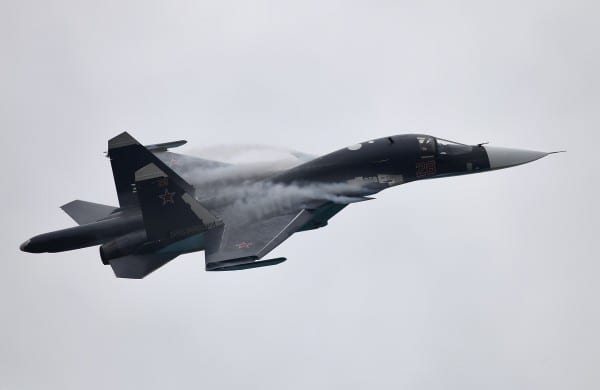
Russia’s Sukhoi Su-34 is an advanced tactical strike fighter. Russia currently has many more advanced planes, some surpassing the US designs. (Wikimedia)
Other current protowar actions against Russia include economic sanctions; the use of the Ukraine crisis as a pretext to mobilize more U.S. and other Nato forces in Eastern Europe for purposes of intimidating or threatening Russia; and the publication by the U.S. media conglomerates of an unending series of lies, half-truths, and obscurantism’s regarding the Ukraine, in order to demonize Russia and prepare the U.S. public to accept whatever actions the U.S. state and military chooses to take.
On the other side of Eurasia, U.S. military encirclement of China has also recently proceeded apace. Military bases and transfers of billions of dollars in military equipment have been positioned around China for years in areas such as South Korea, Taiwan, and Japan.
Now, with the Obama administrations’ so-called ‘pivot to Asia’, a new more ambitious program called ‘Air-Sea battle plan’ involves deployment of large amounts of very hi-tech military systems and equipment in the pacific area all aimed at China.
At the same time, new U.S. military bases are being opened across the Pacific arena, from the Philippines to Australia, with no other conceivable target but China.
In conjunction with this Pacific military build-up, the U.S.state is attempting to use previously minor disputes over ownership of maritime resources to turn a number of smaller Asian nations into proxies to help it destabilize China. These nations include Japan, South Korea, Vietnam, and the Philippines. By offering its support, and in some cases promises of military assistance in any maritime conflict with China, the U.S. has stoked the ambitions and aggressive nationalist tendencies of these smaller nations vis-a-vis China.
Coinciding with the military build-up against China is extensive cyber-penetration of China by the U.S. NSA (National Security Agency), as revealed by whistle-blower Edward Snowden.
This penetration includes wholesale capture of hundreds of thousands or millions of Chinese mobile text messages; the monitoring of mobile phone conversations of Chinese leaders; and serious intrusions into the computer network backbone system of Beijings’ Tsinghua university, which is linked to large numbers of Chinese research centers including labs engaged in sensitive military-related work.
The NSA has also penetrated and compromised the server computers made by Chinese Huaweii, a giant telecommunications equipment and networking company, whose equipment is used throughout China and around the world.
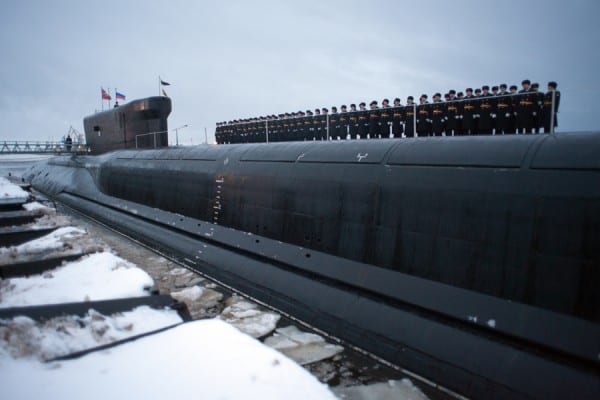
Russia’s strategic deterrent comprises an advanced submarine fleet armed with ICBMs. (Photo: Russian Pacific Fleet).
It should be noted – and emphasized – that the U.S. government has never apologized or stated that these cyber-attacks on China will stop.
Other U.S.attempts to destabilize China include political and economic support for separatist movements by some members of ethnic minorities in the Chinese provinces of Xinjiang and Tibet. Since the 1950’s, first the CIA and later the so-called “National Endowment for Democracy’, which is funded by the U.S. government, have transferred millions of dollars to the so-called Tibetan government-in-Exile in India. Both sets of money transfers are in the public domain, due to the U.S. Freedom of Information Act.
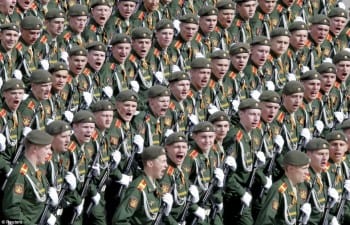
At the same time, a so-called ‘East Turkistani Government In Exile’ claiming to represent XInjiang province was formed in Washington DC in 2004. On his way to the Beijing Olympics in 2008l, then President George W. Bush stopped by the see one of the leaders-in-exile of the Xinjaing separatist movement.
To put all these U.S. protowar actions against China in perspective, we need to consider who is really the aggressive actor in Asia. The U.S. has over 650 military bases in other peoples’ countries, including Asia, while China has none. The U.S. is impinging militarily and politically in China’s backyard; China is not interfering in U.S. relations or military activities in the U.S. backyard. The U.S. has a doctrine of global supremacy; China has no such doctrine and basically wishes to be left alone to develop economically and to engage in economic trade with other nations.
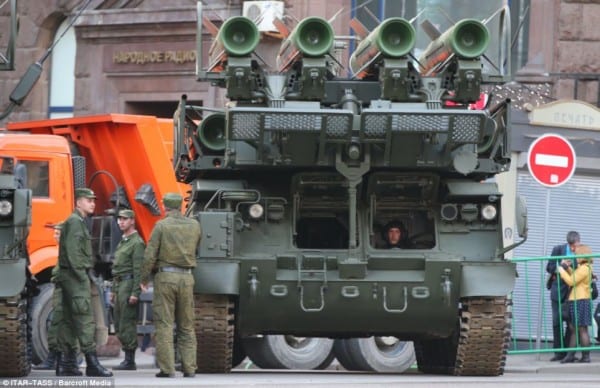
Russian BUK anti-aircraft battery.
The danger of the U.S.Eurasian protowar erupting into hot war – or even nuclear war – stems from a single factor: Previous U.S.-led protowars which erupted into hot wars were against countries like Serbia, Iraq, or Libya. Those countries did not have nuclear weapons and could not effectively defend themselves against U.S. military and other pressures Russia and China are in a different category – they are nuclear- armed and can defend themselves.
The U.S. state presumably does not intend to provoke a hot war with Russia and China.. But directing intensive protowar against powerful nuclear-armed states is to risk the possibility of ‘sleep walking’ into the abyss through miscalculation, or through a gradual hightening of conflicts which finally go out of control. In 1914, with the European powers of the day already on edge, it took just the assassination of a minor duke in a peripheral country to trigger World War I. As an old adage has it, “If you play with fire, you may get burned.”
Eric Sommer is an international journalist.


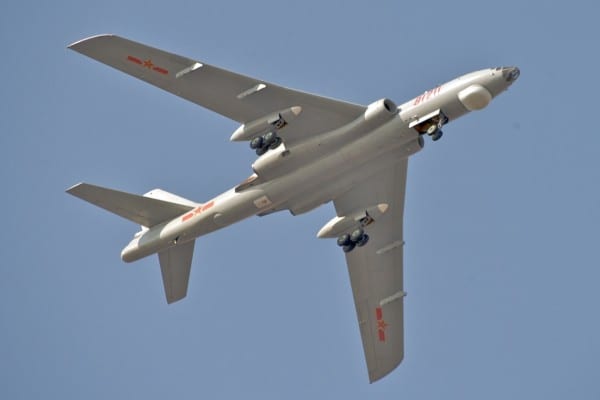




![Former model, rapper and impudent punk Mark Wahlberg is the perfect actor to serve in a jingoist film. An early racist, Wahlberg had been in trouble 20–25 times with the Boston Police Department in his youth. By age 13, Wahlberg had developed an addiction to cocaine and other substances.[9][10] At fifteen, civil action was filed against Wahlberg for his involvement in two separate incidents of harassing African-American children (the first some siblings and the second a group of black school children on a field trip), by throwing rocks and shouting racial epithets.[11] At 16, Wahlberg approached a middle-aged Vietnamese man on the street and, using a large wooden stick, knocked him unconscious while yelling a racial epithet. That same day, he also attacked another Vietnamese man, leaving the victim permanently blind in one eye.[12][13]](https://www.greanvillepost.com/wp-content/uploads/2014/01/markWahlberg898.jpg)



